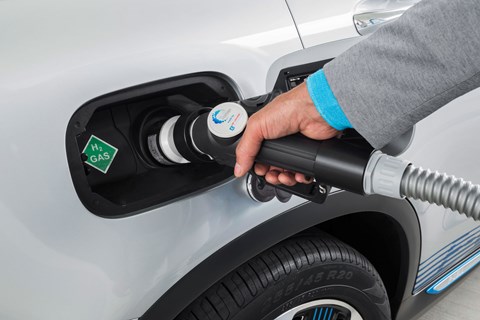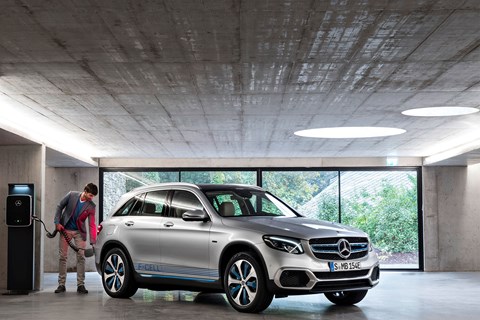► Plug-in hybrid hydrogen crossover
► NEDC range of 241 miles; does 30 on electric
► Slated for launch within a few years
It isn’t just pickups and hypercars that impresses on the Mercedes-Benz stand this year at the Frankfurt show. What you’re looking at here is the GLC F-Cell – a plug-in hybrid with a difference, in that it uses a polymer electrolyte hydrogen fuel cell instead of an internal combustion engine.
Tell me more about that drivetrain…
It takes the form of a 4.4kg cell that can be filled in just three minutes – or around the same time it takes to fill-up your car now – with an NEDC range of 241 miles. This is coupled with a 147kW lithium-ion battery with a 30-mile range for a maximum of 271 miles of theoretical capability.
The battery itself will take 90 minutes to charge using a fast-charger, and the total system output is 197hp with 258lb ft of twist.

Hang on. Wasn’t there a B-Class fuel cell vehicle?
Well remembered. It was called the B-Class F-Cell and went on sale in 2009.
But this is an altogether more compelling proposition. Not only is the GLC’s system 40% more powerful but also 30% smaller, meaning it can be slotted into a conventional engine bay using the same mounts.
Oh, and we actually don’t mind the GLC. It’s among the sportier SUVs on sale, is great to drive and has a neat, well-designed cabin. The B-Class, well… it’s none of those things.
Any other differences compared to the regular Mercedes-Benz GLC?
Merc states a slight lip in the boot (similar to the plug-in hybrid GLC) and a higher seating position for rear passengers as they’re sitting on the hydrogen tanks.
And while that might make the F-Cell sound a little unsafe, said carbonfibre containers have been rigorously tested (we’re told) and conform to globally standardised 700 bar tank standards.

It has the drive modes all cars seem to feature nowadays, giving you the choice between Eco, Comfort and Sport, and the driveline also features four functions to enable the driver to select the sort of power delivery they require.
- In Hybrid mode the car fends for itself, deciding on the optimum level of energy from the fuel cell and batteries.
- In F-Cell, the fuel cell does most of the work, preserving electric range for when it’s most useful – such as for city driving.
- Battery configuration – somewhat unsurprisingly – the car is forced to stay in electric mode for as long as the charge lasts.
- And Charge mode will force the system to charge the battery as quickly as possible, in the process creating power reserves that can be used for ‘dynamic driving’.
How can I spot an F-Cell GLC?
Points of differentiation include the allegedly aerodynamically optimised 20-inch alloys, blue touches on the grille, wheels, side skirts and rear bumper, and redesigned bumpers at both ends including improved frontal cooling through an enlarged air inlet.
Inside there’s a 12.3-inch digital instrument panel along with a 10.25-inch multimedia screen displaying the familiar Comand menus, albeit with a bespoke finish for the F-Cell model. A new touchpad controls all this, able to accept single- and multi-finger inputs along with handwriting.

Aren’t we years behind the infrastructure needed for hydrogen to work?
Yes, but things are moving quickly. While manufacturers clamber to collectively forget diesel ever existed, more and more cash is being poured into alternatives. Parent outfit Daimler claims a network of 100 H2 filling points will be in place by the end of 2018, and that number should quadruple by 2023.
When can I buy one?
Err. That’s a more difficult question. Based on the fact the Mercedes plans to launch 10 battery-electric vehicles between now and 2022, it’s fair to expect no more than a few years’ wait for cars to hit dealerships proper. The cars on the Frankfurt stand are billed as ‘pre-production’ models, but they look pretty well finished to us…
Click here for our full A-Z guide to all the new cars at Frankfurt 2017